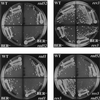Overlapping specificities of base excision repair, nucleotide excision repair, recombination, and translesion synthesis pathways for DNA base damage in Saccharomyces cerevisiae
- PMID: 10082560
- PMCID: PMC84087
- DOI: 10.1128/MCB.19.4.2929
Overlapping specificities of base excision repair, nucleotide excision repair, recombination, and translesion synthesis pathways for DNA base damage in Saccharomyces cerevisiae
Abstract
The removal of oxidative damage from Saccharomyces cerevisiae DNA is thought to be conducted primarily through the base excision repair pathway. The Escherichia coli endonuclease III homologs Ntg1p and Ntg2p are S. cerevisiae N-glycosylase-associated apurinic/apyrimidinic (AP) lyases that recognize a wide variety of damaged pyrimidines (H. J. You, R. L. Swanson, and P. W. Doetsch, Biochemistry 37:6033-6040, 1998). The biological relevance of the N-glycosylase-associated AP lyase activity in the repair of abasic sites is not well understood, and the majority of AP sites in vivo are thought to be processed by Apn1p, the major AP endonuclease in yeast. We have found that yeast cells simultaneously lacking Ntg1p, Ntg2p, and Apn1p are hyperrecombinogenic (hyper-rec) and exhibit a mutator phenotype but are not sensitive to the oxidizing agents H2O2 and menadione. The additional disruption of the RAD52 gene in the ntg1 ntg2 apn1 triple mutant confers a high degree of sensitivity to these agents. The hyper-rec and mutator phenotypes of the ntg1 ntg2 apn1 triple mutant are further enhanced by the elimination of the nucleotide excision repair pathway. In addition, removal of either the lesion bypass (Rev3p-dependent) or recombination (Rad52p-dependent) pathway specifically enhances the hyper-rec or mutator phenotype, respectively. These data suggest that multiple pathways with overlapping specificities are involved in the removal of, or tolerance to, spontaneous DNA damage in S. cerevisiae. In addition, the fact that these responses to induced and spontaneous damage depend upon the simultaneous loss of Ntg1p, Ntg2p, and Apn1p suggests a physiological role for the AP lyase activity of Ntg1p and Ntg2p in vivo.
Figures



References
-
- Augeri L, Lee Y M, Barton A B, Doetsch P W. Purification, characterization, gene cloning and expression of Saccharomyces cerevisiae redoxyendonuclease, a homolog of Escherichia coli endonuclease III. Biochemistry. 1997;36:721–729. - PubMed
-
- Bierne H, Michel B. When replication forks stop. Mol Microbiol. 1994;13:17–23. - PubMed
-
- Boeke J D, Trueheart J, Natsoulis G, Fink G R. 5-Fluoroorotic acid as a selective agent in yeast molecular genetics. Methods Enzymol. 1987;154:164–175. - PubMed
-
- Brennan R J, Swoboda B E, Schiestl R H. Oxidative mutagens induce intrachromosomal recombination in yeast. Mutat Res. 1994;308:159–167. - PubMed
Publication types
MeSH terms
Substances
Grants and funding
LinkOut - more resources
Full Text Sources
Other Literature Sources
Molecular Biology Databases
Research Materials
